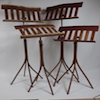I have a Leigh Dovetail Jig that I use almost exclusively for half blind joints and was wondering if anyone uses a bit with a guide bearing instead of a guide bushing collar? It seems that this arrangement would remove the variable of not having your guide bushing centered perfectly on the router base. Most of the drawer boxes I made are with 1/2" stock and this requires an 18 degree bit. I quick Google search didn't turn up any bits like this with the bearing collar.
And thoughts both pro or con would be appreciated.




 Reply With Quote
Reply With Quote


